There is a sycamore in the front yard of my grandparents’ house, the house where my father grew up. It is a giant, towering over the home, the yard, the whole neighborhood. Last spring, when my grandmother was fading and the tree was coming into leaf, I stood under the sycamore for a long while, listening to the wind rustling its new growth. It was a delicate sound that, every so often, turned into a tremendous roar as the breeze went gusty.
My grandmother died a few weeks later. She was 101. The tree must be at least as old. Several months after she died, once the house was ready to sell, we all fell into a minor panic about the future of our beloved sycamore. Surely, anyone buying this small, old house would be developing the lot, and would take down the tree.
A sycamore tree in Griffith Park.
(Devin Oktar Yalkin / For The Times)
But a day or two later, we learned that it is rather difficult — and also, illegal — to cut down a very old, still-alive sycamore, oak, California bay or black walnut in Los Angeles. It turns out the city has an entire department — its urban forestry division, and specifically its tree czar, Rachel Malarich — responsible for, among other things, saving such trees. All it took was alerting the office to the location and existence of our sycamore and the division would, if it hadn’t already, add it to its ever-growing list of trees it aims to protect.
I wrote “our sycamore” above, but great trees defy possessives. They are home to bees and birds and squirrels and ants and countless other critters. They are often older than all of us, older than the sidewalks, the streets, the parks. Older, sometimes, than the city itself.
These trees, belonging to no one, are for everyone.
The old sycamore was on my mind when, a few months ago, I got the idea to find and visit the greatest trees in all of Los Angeles. The idea wasn’t entirely my own — I was cribbing it from a tree of the year “contest” held in the United Kingdom, which, I came to learn, was itself part of a larger, European-wide tree of the year contest that includes at least 15 other nations, and began in the Czech Republic more than a decade ago.
Like the judges of these contests, I was interested in old, big trees — the sort of trees that tree pros and tree enthusiasts like to call specimens. I started my search for specimens by talking to many, many tree people: arborists, landscape architects, gardeners and garden nerds, historians and activists, tree-heads all. Like Jorge Ochoa, a horticulture professor at Long Beach City College, who suggested the tree he gets asked to identify most: a huge araucaria, also known as a bunya-bunya, that appears in the film “Blood In, Blood Out” and is an icon of East L.A. Or Jenny Jones, a landscape architect at Terremoto, who mentioned a “profoundly beautiful” mulberry in the Elysian Heights Elementary school garden. Leigh Jerrard, at Greywater Corps, said his favorite tree in L.A. was a valley oak on Chesebro Road in Agoura Hills, but then he caught himself. Had it survived the Woolsey fire a few years back? He wasn’t sure. He texted me a few days later. Nope. It was no longer alive.
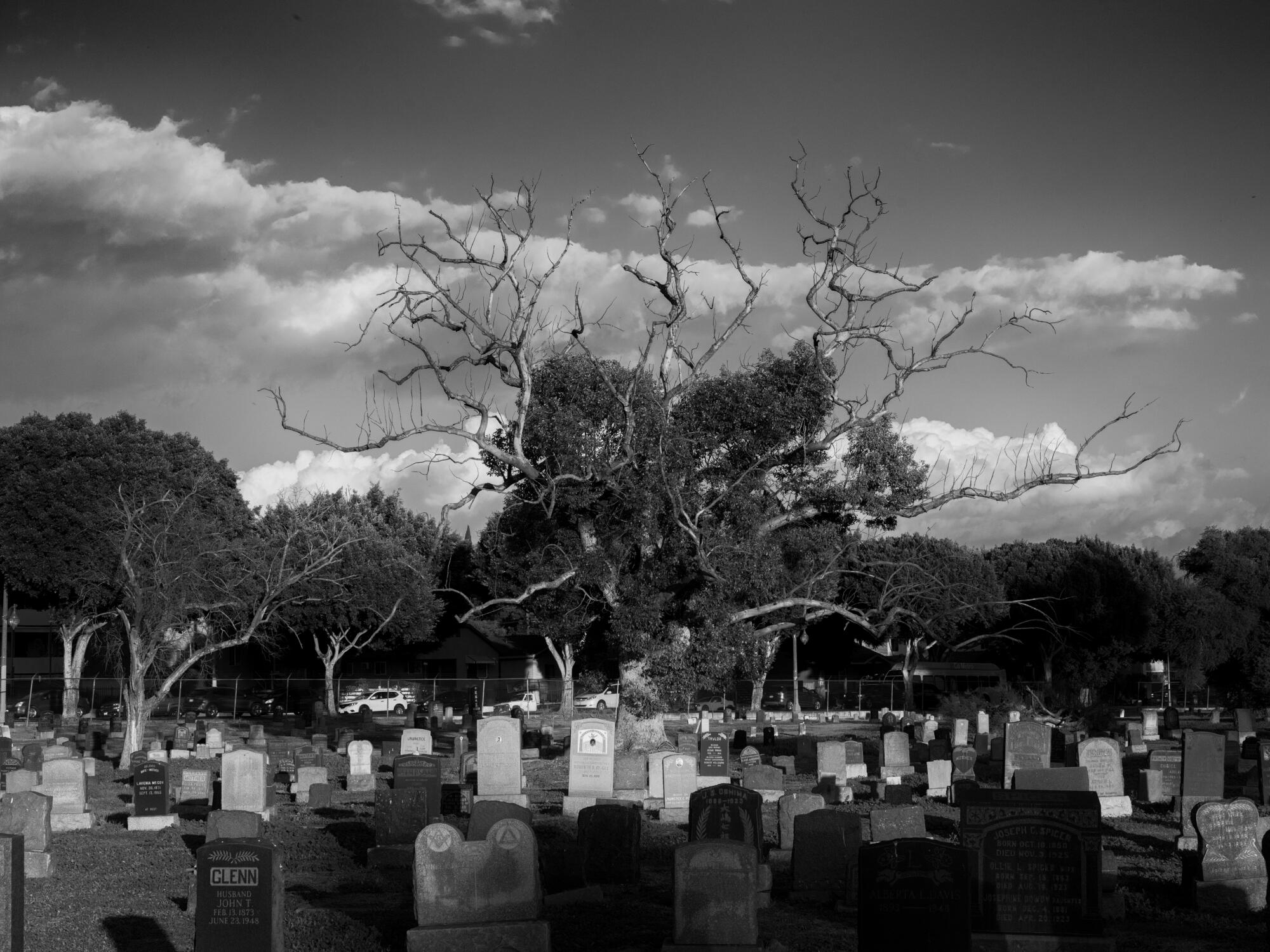
A camphor tree, Cinnamomum camphora, at Evergreen Cemetery.
(Devin Oktar Yalkin / For The Times)
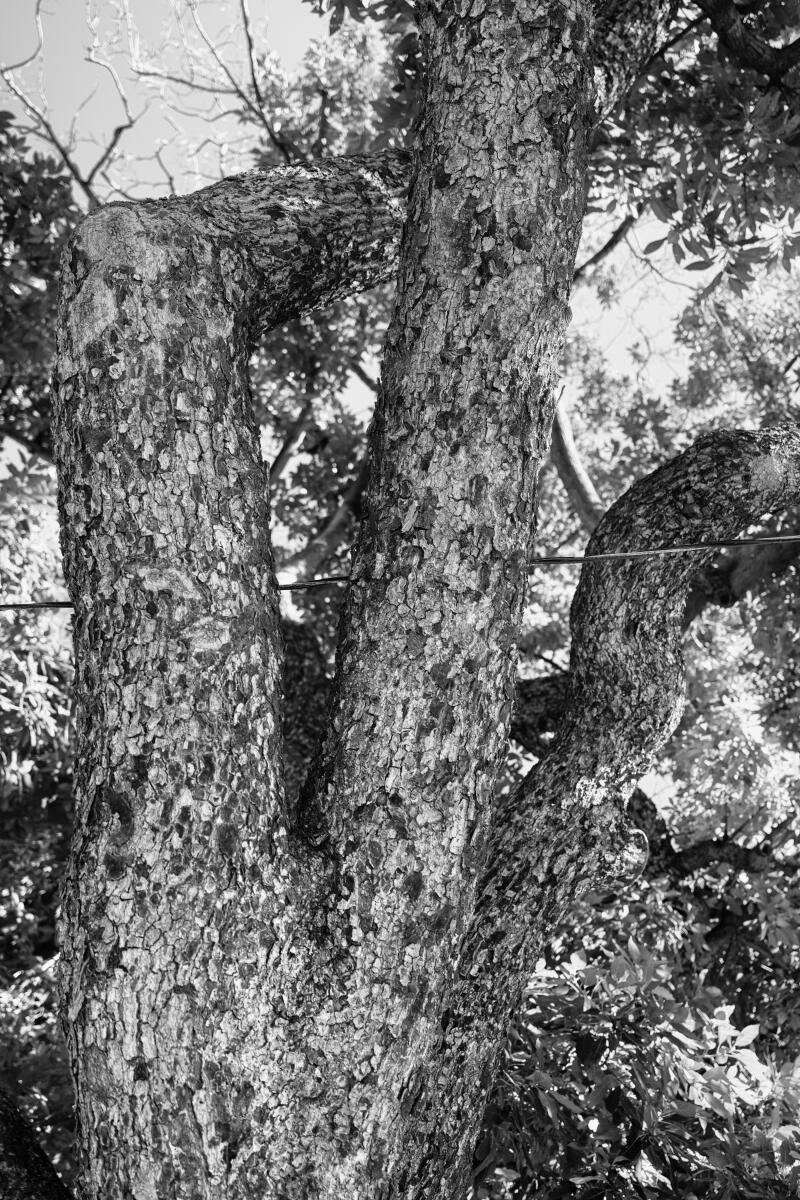
Giant avocado tree in Atwater, near the L.A. River. (Devin Oktar Yalkin / For The Times)
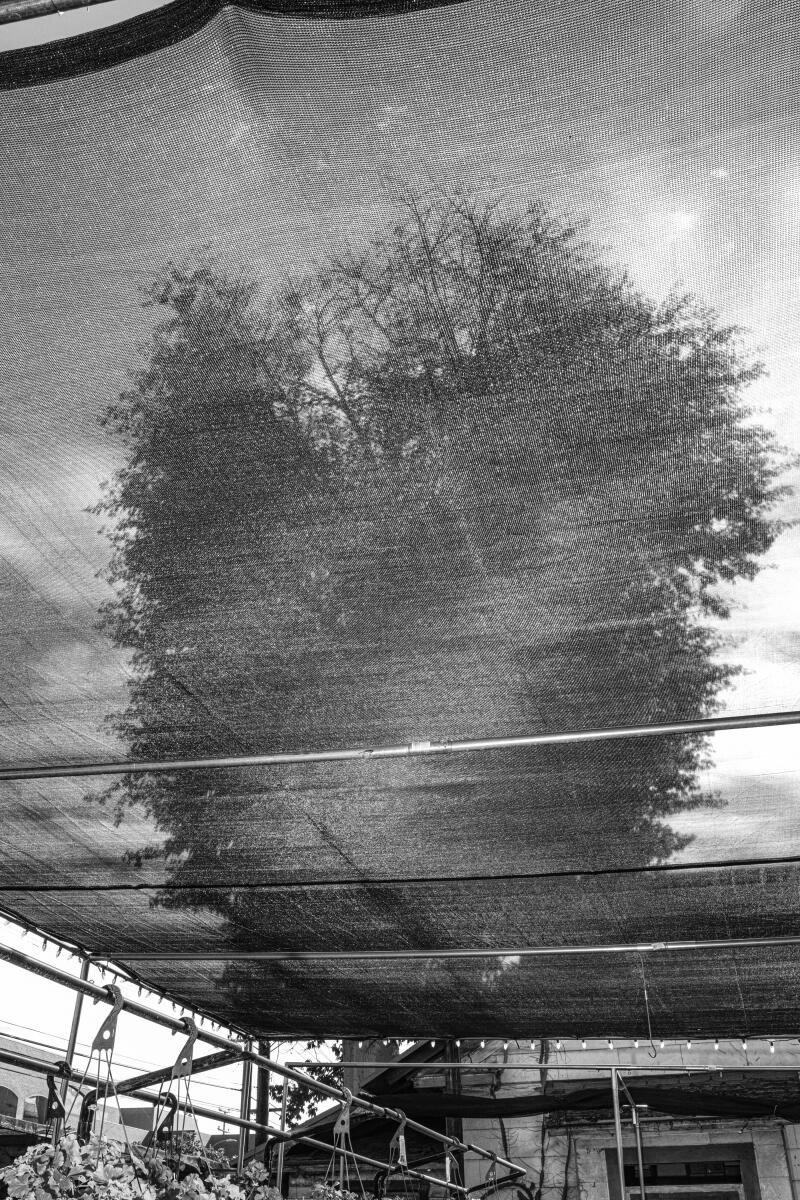
A floss silk tree towers over the Yamaguchi Bonsai Nursery. (Devin Oktar Yalkin / For The Times)
This was the case with a lot of legendarily great L.A. trees: They were now dead. A few different tree-heads mentioned the gigantic silk floss that was once at the Hotel Bel-Air, and many more suggested the Encino Oak, which by some estimates was already 500 years old when the first Spanish expedition through California camped under it. But Jeff Perry, who knows fallen trees, told me that the greatest L.A. tree of all once stood on what is now Commercial Street at the 101 Freeway, not a half-mile from Angel City Lumber, which Perry runs.
“This tree is so important,” he told me. “It was the centerpiece of the Tongva village here. It stood when the pueblo was established, when Mexican occupation took over, when American occupation took over.” A winemaker shaded his casks under its limbs, then German immigrants bought the winery and turned it into a brewery. Eventually the tree, which had long been known as El Aliso — Spanish for sycamore — was turned into firewood. “The point,” Perry said, “is that this was a tree that witnessed multiple layers of colonization.” Today, on the corner by the freeway onramp, there is a small plaque about El Aliso, the great tree that stood there for so long, and saw so much.
Another, more recently dead great tree that I kept hearing about was the Eagle Tree, another huge sycamore and an old Compton landmark. Its trunk has been saved, and there are now plans to distribute young clones of the Eagle Tree throughout the Southland, thanks in large part to the work of Kim Cooper and Richard Schave, preservationists who run the L.A. tour company Esotouric. There were many other trees Cooper and Schave mentioned — East L.A.’s El Pino, an old queen palm on Bunker Hill called Sunshine, some more very old bunya-bunyas at Rancho Los Amigos — and several other trees out there to save and celebrate before they expire. But before all that, they told me, I simply had to speak to Don Hodel.
This was not the first nor the last I would hear of Hodel. In fact, pretty much every other tree-head I spoke to mentioned him either right off or in closing, or followed up a day or two later with something along the lines of what Cooper and Schave had said: that if I was looking for great trees, the best trees, the trees worth celebrating, I really ought to be talking to Don.
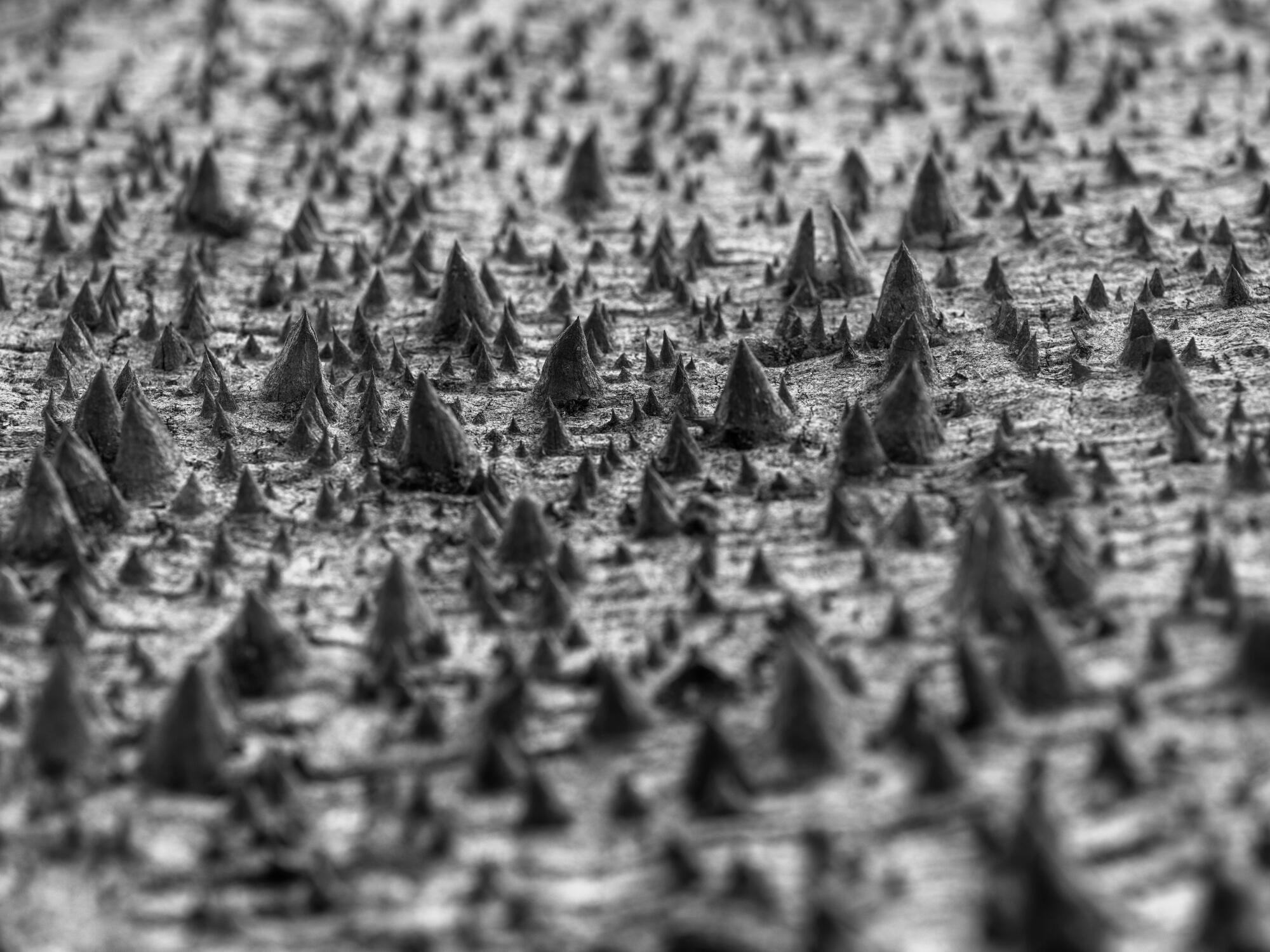
The prickly surface of the floss silk tree near Yamaguchi Bonsai Nursery.
(Devin Oktar Yalkin / For The Times)
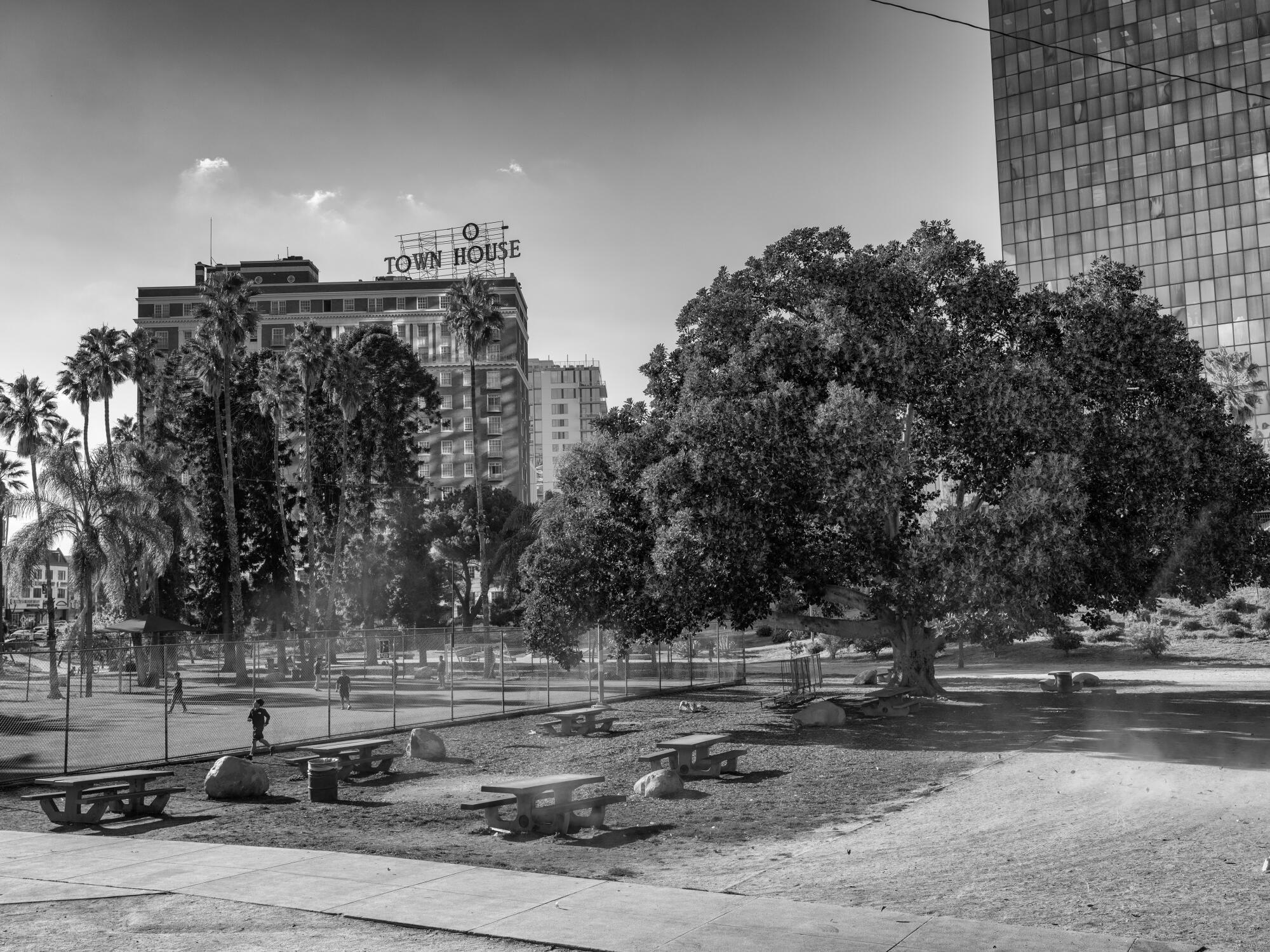
Ficus religiosa, Lafayette Park. Commonly called bo tree, it’s famous for being the same species that the Buddha meditated under when achieving enlightenment.
(Devin Oktar Yalkin / For The Times)
Donald R. Hodel is the emeritus environmental horticulturist for the University of California Cooperative Extension in Los Angeles. In 1988, Hodel authored a book, published by the California Arboretum Foundation, titled “Exceptional Trees of Los Angeles.” It is exactly what its title describes: a book of very good — or, I’m sorry, exceptional L.A. trees. It is long out of print, but I found a copy, and was thumbing through it when we spoke.
I told Hodel about my plan, which had, after several weeks among the tree-heads, plus some scouting missions, been refined a touch. I was after, I’d decided, only the most public of trees, which meant simply: the more accessible, the better. Sure, there was a California buckeye I adored at Descanso Gardens, but any place you had to pay to see a tree was out. As were trees in private backyards, or high-fenced front yards. The tree had to be highly visible, enjoyable and not a tree you had to hike too far to see. If it was in a public park, then at most it might require a minor walk, ideally not even uphill. If it was the sort of tree someone (someone who was not yet a tree-head) might drive by all the time and not really notice, or notice but think simply, “Huh, what a large tree!” — that was perfect.
Hodel thought first of the many streets in L.A. lined with great, glorious tree plantings: the coral trees along San Vicente, the Canary Island date palms lining the entrance to Dodger Stadium, the gum myrtles on Kenilworth Avenue in Pasadena and, of course, in Altadena, the deodar cedars along Christmas Tree Lane (“a spectacular planting,” Hodel said). But when I explained that it was specimens I was after, I heard Hodel go silent a moment. He had his book out too, and was flipping through it. “Some of these trees,” he said quietly, almost to himself, “I haven’t been back to them in 30 years, and they may not be there.”
Hodel then told me about a grapefruit tree in Little Tokyo that was planted about 150 years ago by Japanese American settlers as part of the first citrus grove in Los Angeles. For decades, the tree sat behind a building in a vacant lot, until the neighborhood rallied to save it, and replanted it in the courtyard of the Japanese American Cultural Center. It was by now very likely the oldest citrus in L.A., certainly the only one left from that original grove. “Ask if it’s still standing,” Hodel told me. And, later, I did. Reader, it is.
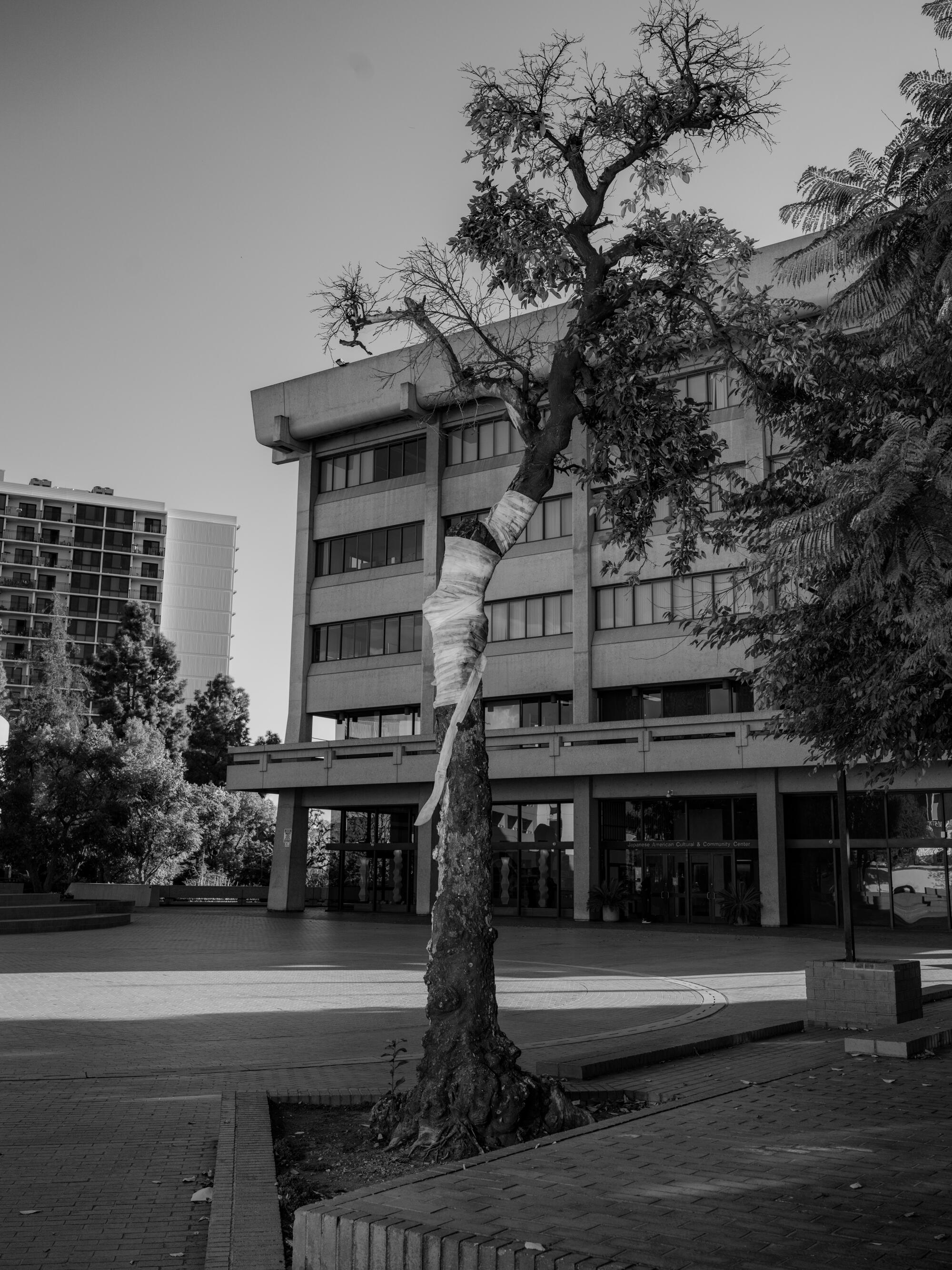
The 150-year-old grapefruit tree in the courtyard of the Japanese American Cultural Center.
(Devin Oktar Yalkin / For The Times)
There were also, of course — Hodel continued — the ficuses; the Moreton Bay figs in particular, which get absolutely gargantuan, and are never not notable, lining as they do La Mesa Drive in Santa Monica, or Vermont Avenue on its approach to Griffith Park, or spreading their branches out over the Pacific Ocean on Point Fermin in San Pedro, or beside the old library in South Pasadena. But one of his favorites — and mine, it turned out — was next to St. John’s Presbyterian Church, on National Boulevard, a few blocks from where the 10 Freeway crosses the 405 Freeway. This one tree takes up practically the whole block, was planted in 1875, and is the sort of specimen that can cause someone to gasp, and gawp, and long to pull over and stand beneath it for a while, just contemplating things like time and space and root systems.
Hodel had given me more than a few great trees but I was a greedy, half-tree-mad man by now. I wanted more: more trees, older trees, even better trees. He mentioned Orcutt Ranch, which, he said, had some of the oldest valley oaks around, and an even older coastal live oak, so old you could still see on it the scars from where its branches had been removed to fire the kilns that made the adobe brick that built the San Fernando Mission. “Lot of history tied up in those old oaks,” Hodel said.
About a week later, I visited the oak, which is a short walk from the parking lot to the back of the property, the last small parcel of a once-sprawling ranch that is now a public park. The tree has the look of an ancient thing — knobby and gnarled and thick, so thick and tall it appeared at times like several oaks stacked on top of one another. A tree like this is practically planetary; it creates its own ecosystem, and while we — photographer Devin Yalkin and I — stood in its silence and stillness for a spell, we also began to notice all the life within it and upon it: We counted at least two beehives, a half dozen squirrels, several California towhees and oak titmouses, many, many lesser goldfinches, huge networks of spiderwebs, plus dark holes and hollows throughout the oak that were certainly home to many more creatures we could not see. This tree, by some estimates, is at least 700 years old, which would make it a likely candidate for the oldest tree in all of L.A.
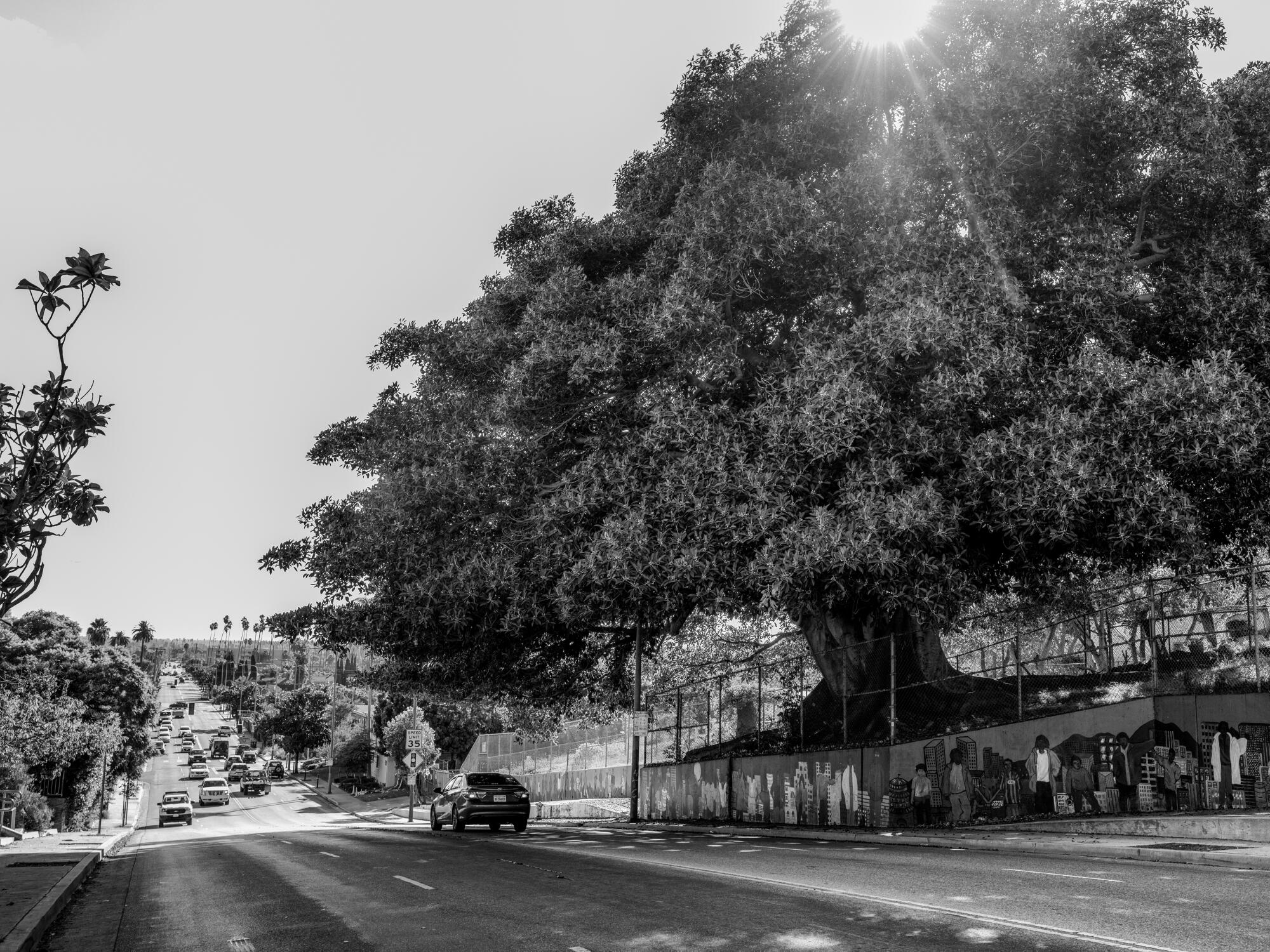
An excellent Moreton Bay fig tree at Mid-City’s Prescott School.
(Devin Oktar Yalkin / For The Times)
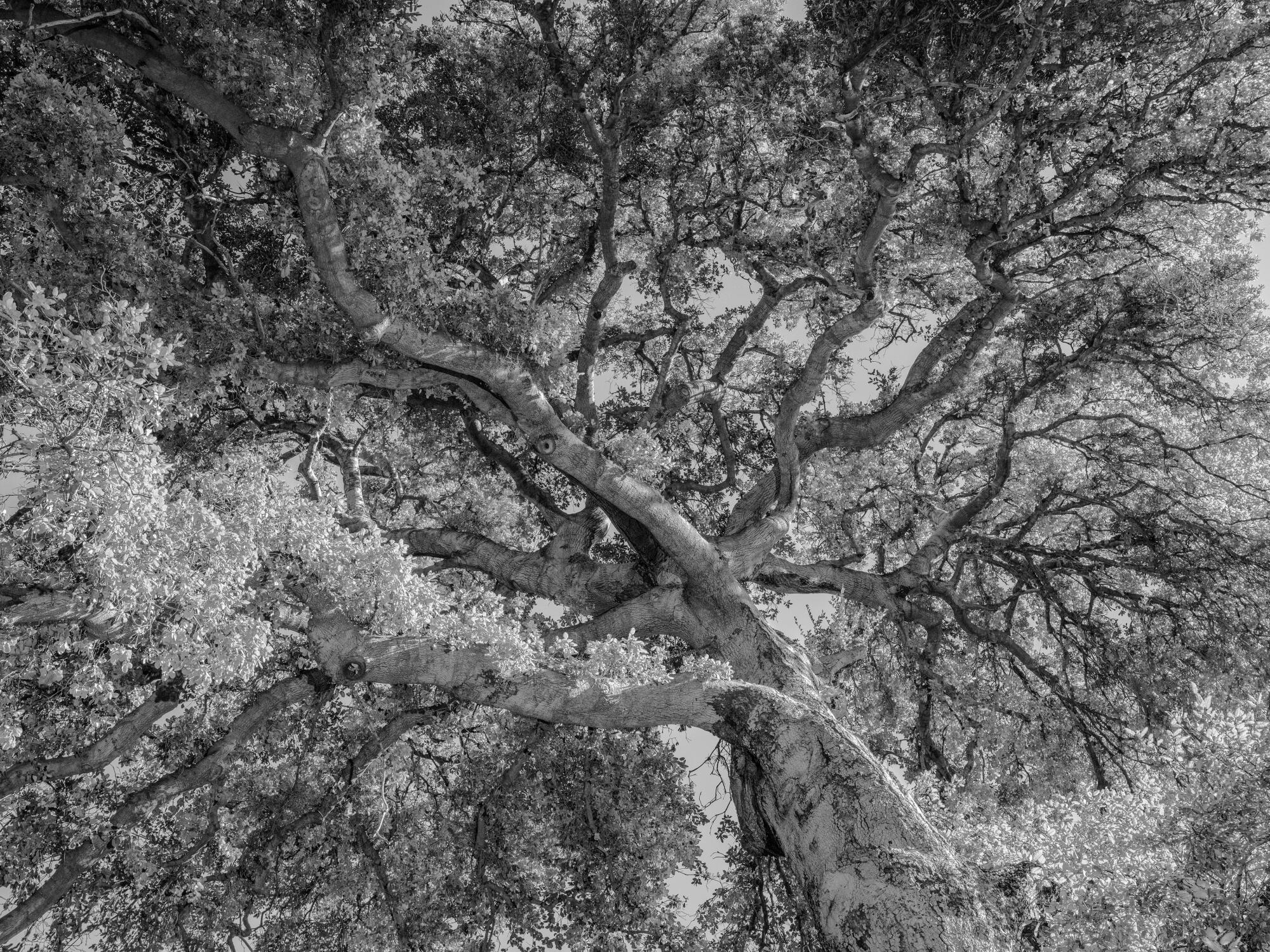
Among the oldest trees in Los Angeles, a coastal live oak at Orcutt Ranch.
(Devin Oktar Yalkin / For The Times)
But the day was young, and we still had many more trees to see, so after an hour or so, we drove across the San Fernando Valley, up and over the hills to the triangle where Cahuenga crosses Franklin, to an entirely different sort of specimen: a handsome jacaranda, not so incredibly old, not even especially big, just beloved, and beset on all sides by the city. I had heard about this tree from Nick Araya, an arborist who runs TreeCareLA. This tree, he told me, was managed by the surrounding neighborhood; they had a committee for it, even. Last year, Araya had been contacted by the neighborhood tree committee after the jacaranda in the triangle had been mysteriously vandalized. Someone, or something, had pruned a large portion of the tree. “They almost ruined it,” Araya said.
Araya sent his colleague Oscar Sanchez out to investigate, and Sanchez eventually figured out that someone, likely employed by some corporate entity (an advertising agency, perhaps), had illegally chopped the tree just to make a nearby billboard more visible. “Corporate vista pruning,” Sanchez called it. But people, Araya pointed out, obviously care more for trees than they do for billboard advertisements. And indeed, after a short time looking at the jacaranda, a man walking a small dog cautiously approached. His name was Louis Alfaro. The dog was his neighbor’s, and named Nacho. Alfaro was very worried about what we might be doing to the tree — did we work for the city? Was Devin photographing the site to take down the tree? It was one of the few patches of nice green shade, and there was already so much vandalism around it, he said. He’d lived in an apartment in the neighborhood for 11 years and visited the tree almost every day.
Wherever Araya goes in the city, tending trees, he encounters folks like Alfaro, who care deeply for specimens that are not on property they own, that are not their own trees, but they feel an ownership and responsibility for them all the same. Araya also catalogs champion trees — the largest specimens in the state or even the country — wherever his work takes him, which is all across L.A. One of his favorite specimens to send fellow arborists out to is the towering silk floss in back of Yamaguchi Bonsai Nursery on Sawtelle. He’s also particularly fond of a Moreton Bay fig that’s spilling over the muraled retaining wall of Mid-City’s Prescott School.
Among the other L.A. champions in the registry of California Big Trees is the state’s largest avocado tree, in Atwater, as well as the largest Canary Island pine, in Lawndale, and the largest deodar cedar, in Lafayette Square. These are all common trees that can be seen throughout the backyards and supermarket parking lots of Los Angeles. But these individuals have grown old and huge and worth celebrating, even if they happen to be unassuming and unexpected, situated as they are on quiet residential streets.
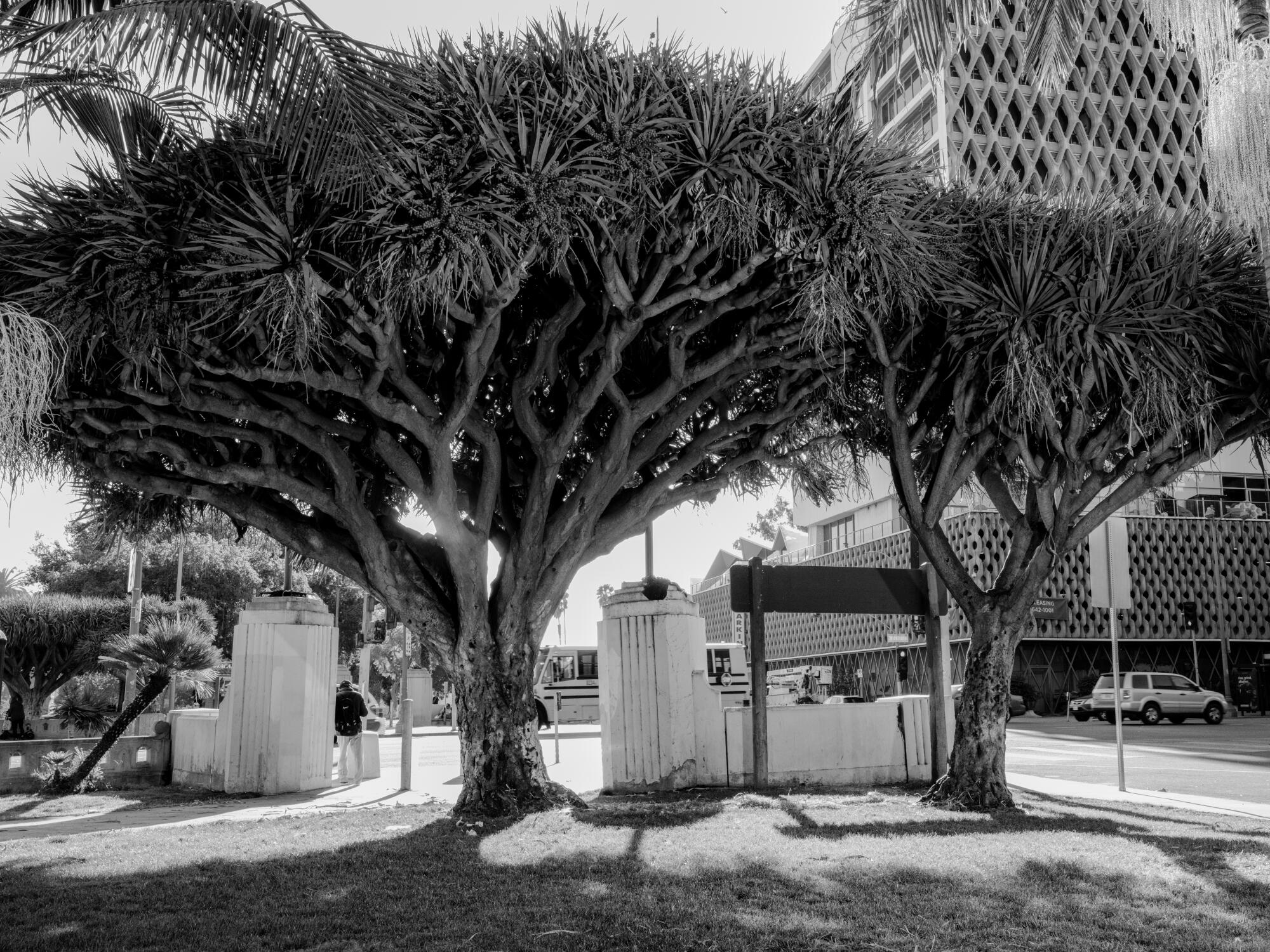
Dragon trees in downtown L.A.
(Devin Oktar Yalkin / For The Times)
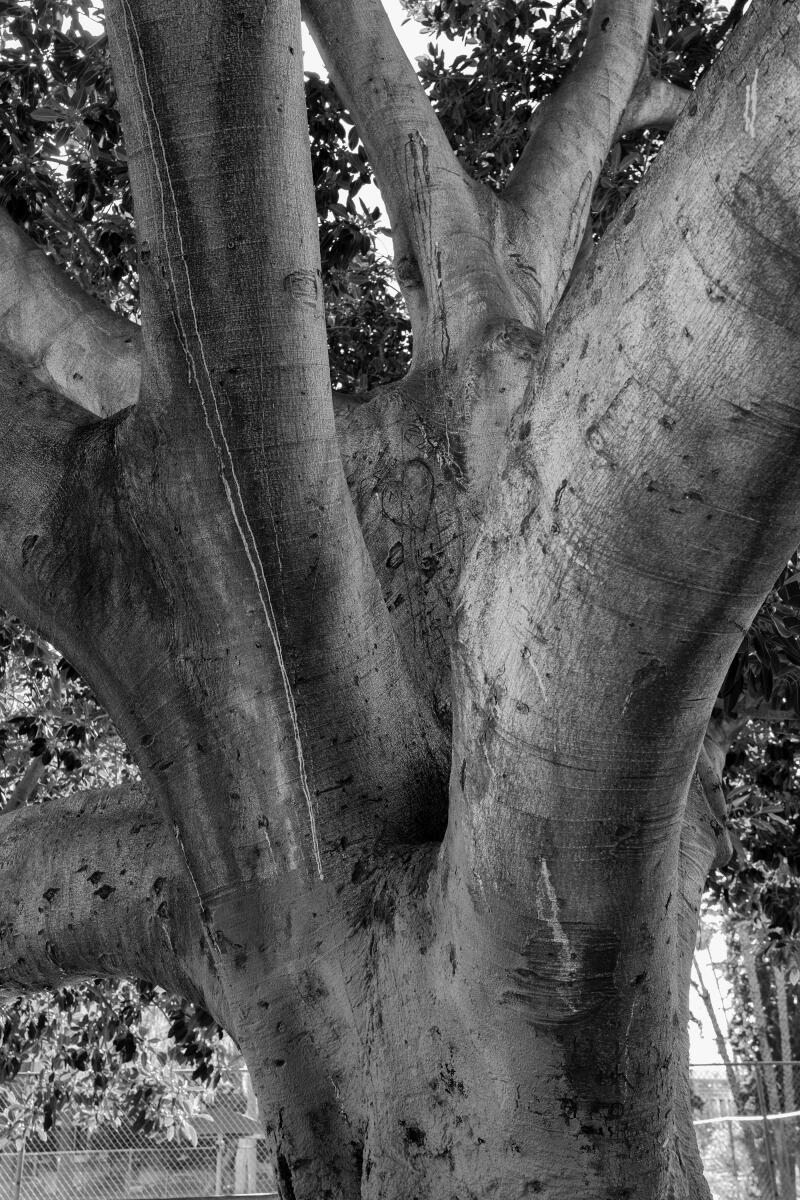
The oldest plant in the world of known planting date is the Ficus religiosa Sri Maha Bodhi, which was planted in Anuradhapura, Sri Lanka, in 288 BC. Today, the bo tree is revered as a symbol for prosperity, happiness, good fortune and long life. (Devin Oktar Yalkin / For The Times)
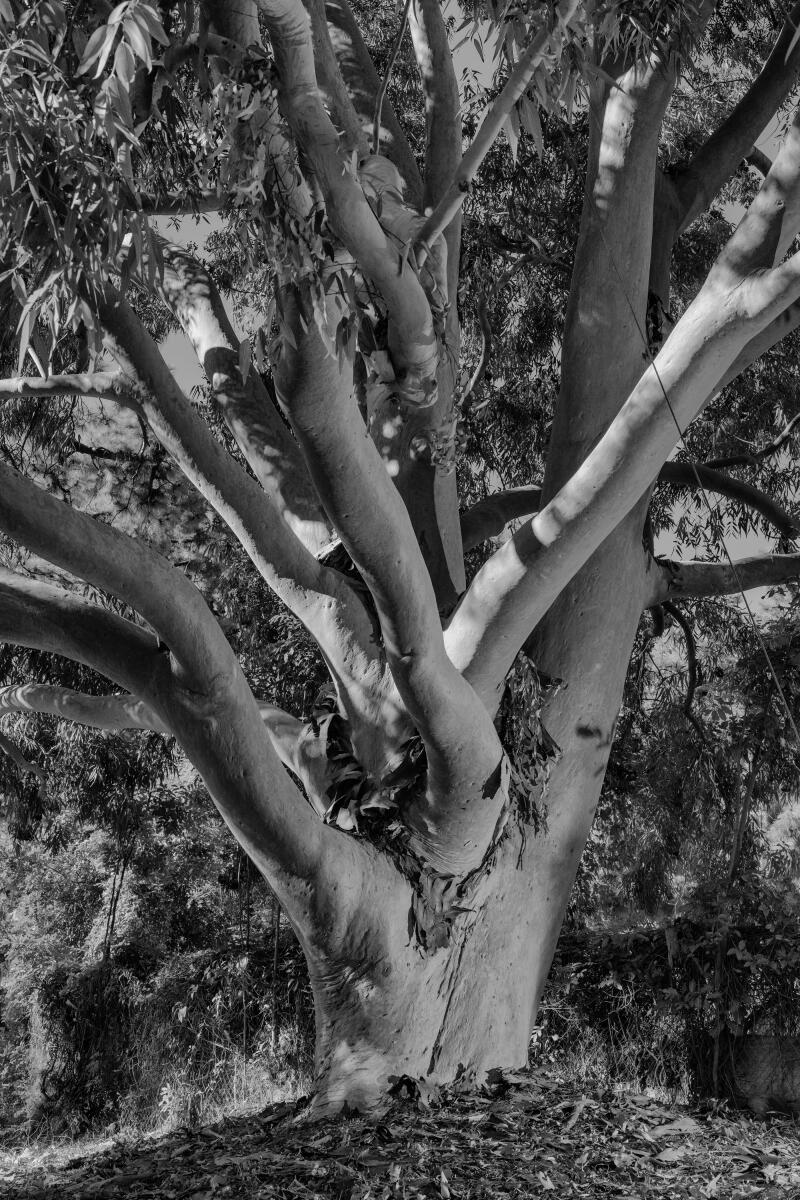
The champion rose gum tree. (Devin Oktar Yalkin / For The Times)
Outside of the city’s parks department maintenance yards is another such champion, a rose gum, which is also known as a smooth-barked apple gum. Like many other very large trees in L.A. — the eucalyptuses, the bunya-bunyas, the Moreton Bay figs — it hails from Australia. As Devin and I were taking it in, Leon Boroditsky, the principal forester for the city’s parks department, walked out to meet us. His office is just across the street. What Boroditsky likes about this tree, beyond its pleasantly smooth bark and rosy shade, is that it’s an anonymous tree. That is, we do not know who planted it, or exactly when, or how. It is on a street corner that was once part of Griffith Park, and it’s possible that someone, long ago, simply acquired an interesting sapling of an exotic tree, had no yard in which to plant it, so planted it in what was, back then, the park. And now, here it is: a towering testament to one Angeleno’s long-ago hopes for the city’s future.
Trees are like that, existing as they do on a timescale so different from our own; they connect us to a distant past while also bearing witness to a future we will never live to see. After months spent searching for the greatest trees in L.A., I’ve come to realize that what I believe makes a tree great is not necessarily its size or its age but its ability to keep on living, especially if it has persisted despite prolonged neglect. That a tree, particularly a tree in a tree-poor part of town (of which there are, in L.A., far too many) endures is — well, it’s a very hopeful thing, isn’t it?
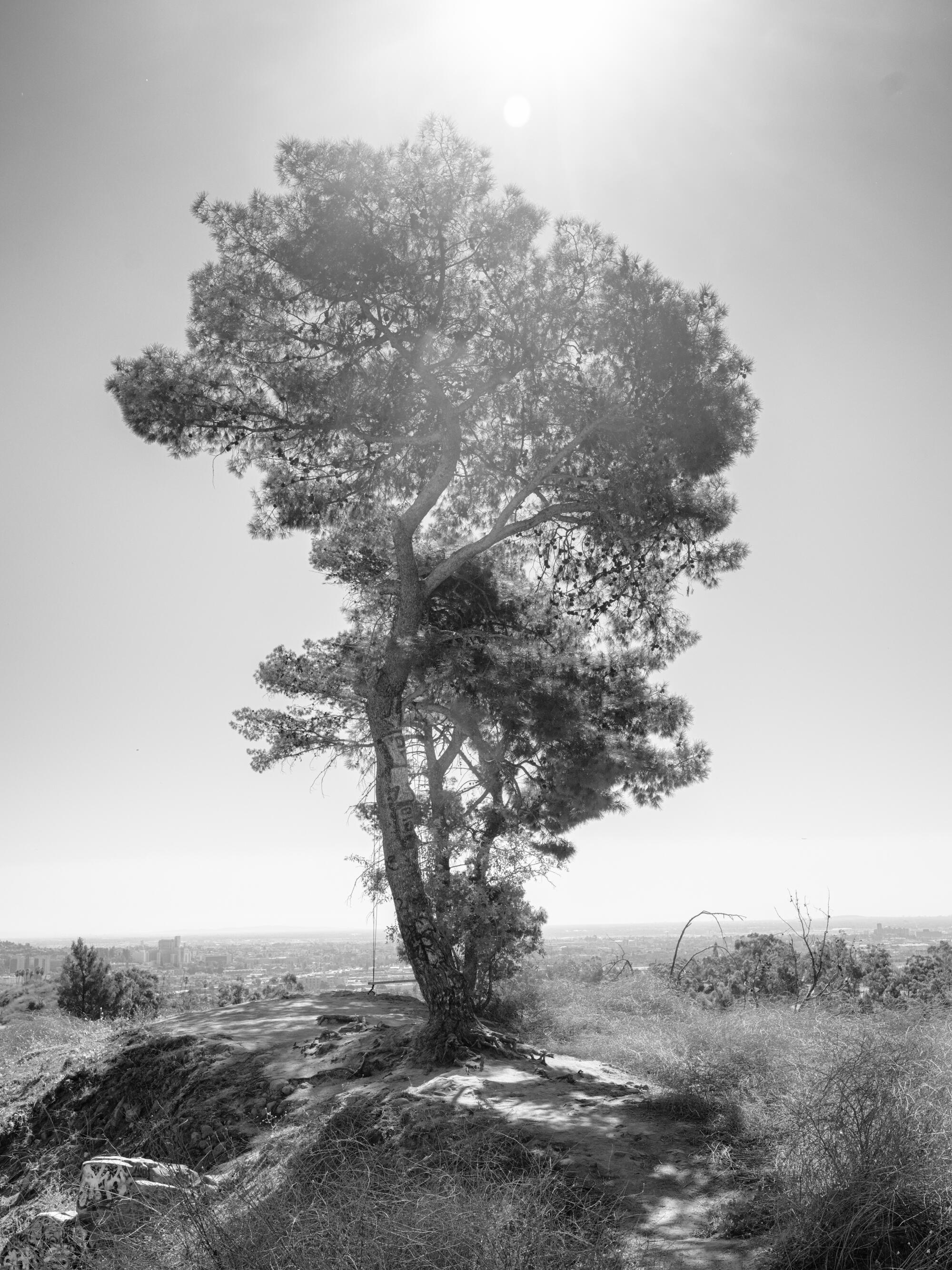
Aleppo pine, the tallest pine species that grows in L.A. This one is at the top of a hill overlooking the 5 Freeway and L.A. River in Elysian Park. Someone added a swing.
(Devin Oktar Yalkin / For The Times)
I suppose this is a roundabout way of explaining why it is that quite a few of what have become my favorite trees in L.A. are not the sort of trees that judges of any tree competitions may necessarily deem great. Many are still quite young, so really what I like about them is their potential, like some of the more than 400 trees planted in and around Skid Row by folks at Industrial District Green; or the still-young coastal live oaks and black walnuts, many planted by North East Trees, which as they grow and fill in will make up a dense microforest in Ascot Hills Park; or many young trees planted throughout city parks in Long Beach, Cerritos, Lakewood and Seal Beach, many rare and cultivated by Hodel for an organization called Southeast Trees.
The other sort of trees I love are the trees that have, despite our best efforts, endured, like a red river gum eucalyptus in West Carson. This tree sat alone for years and years in an old industrial brownfield, the site of a former synthetic rubber factory, putting down its roots in poisoned earth, surrounded by scrap yards. The tree is just about the tallest feature for a mile in any direction, a lighthouse for nature that draws people to it. And now, the eucalyptus is the heart of a soon-to-open park, developed by the Los Angeles Neighborhood Land Trust, named Wishing Tree Park. That’s what a great tree can be: a witness, a wish, a beacon — hope. A great tree is the park that got built around the tree, because it held on long enough for enough of us to finally take notice.
Do you have a favorite tree in L.A.? Tell us about it here.


